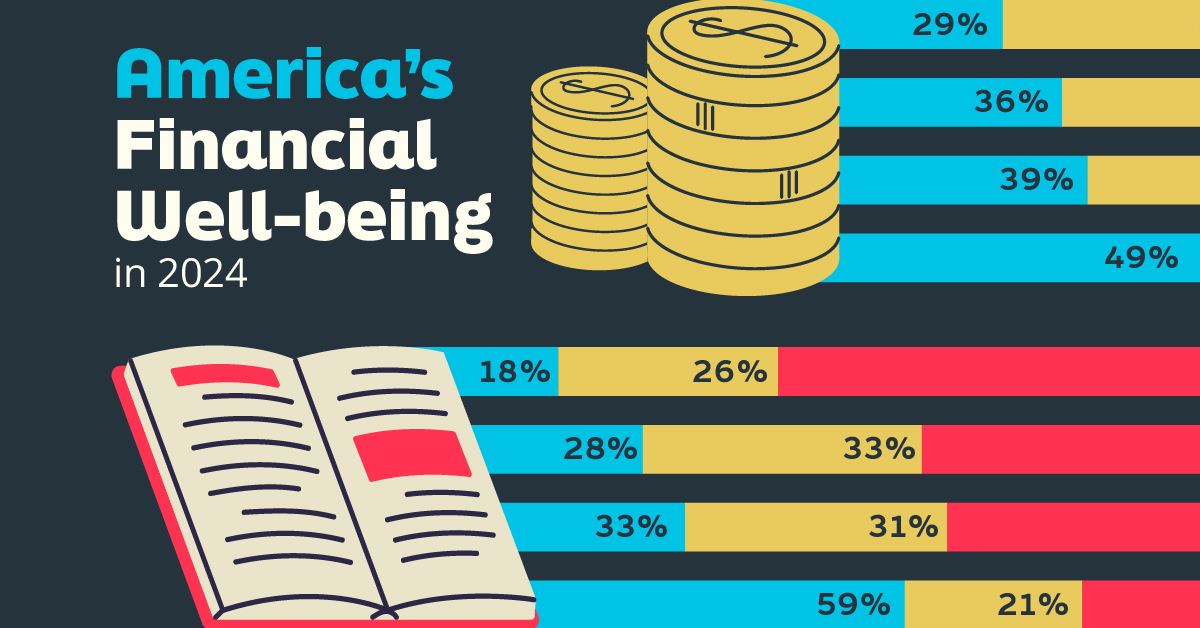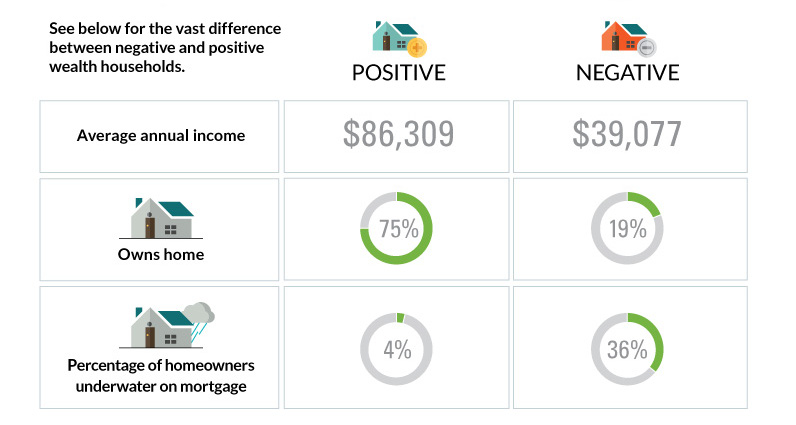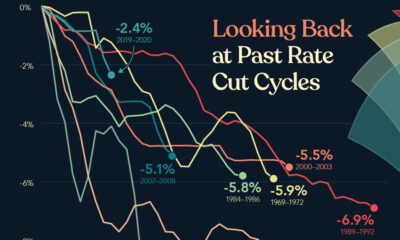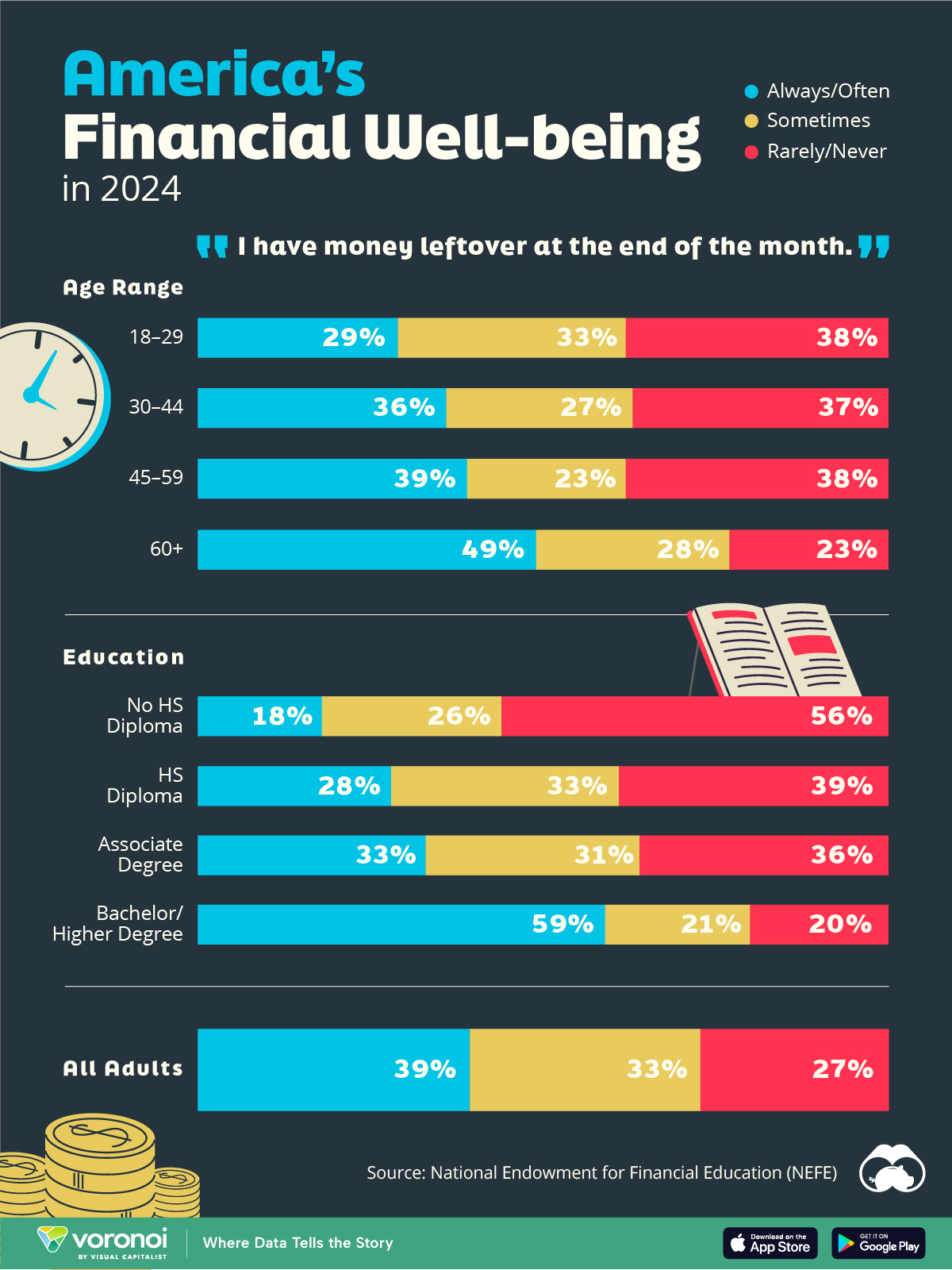Money
Chart: 14% of Americans Have Negative Wealth

Chart: The Profile of a House With Negative Wealth
14% of all U.S. Households Have More Debts Than Assets
The Chart of the Week is a weekly Visual Capitalist feature on Fridays.
According to the New York Federal Reserve, 14% of the U.S. population lives in households that have “negative” wealth. In other words, these are households that have more debts piled up than assets, which puts their net worth in minus territory.
But what does a negative wealth household look like?
In today’s chart, we compare the data on negative wealth households with the data on their positive counterparts. There are some obvious and stark contrasts.
Positive vs. Negative Households
At the household level, the differences are probably what you would expect.
Negative wealth households bring in $39,077 in annual income, and only 19% of these families own their home. More than one-third (36%) of these mortgages are underwater.
Meanwhile, positive wealth households bring in $86,309 in annual income, and 75% of the families own their home. Only 4% of the mortgages are underwater.
The Head of the Household
For each of these households, we have data on the person that is the head of the household, or the breadwinner for each family.
In terms of education, there isn’t a big difference between the heads of negative and positive wealth households. Both seem to be similarly accomplished in terms of achieving college degrees (43% vs. 45%) and postgraduate degrees (12% vs. 15%).
However, there are greater differences when it comes to demographic profiles.
Negative wealth households have heads that are younger (43 vs. 51 years old), female (69% vs. 45%), and single (57% vs. 33%). There is also a higher proportion of minorities (24% vs. 17%) and single parents (20% vs. 7%) living in negative wealth households.
The Have and Have Nots
We also wanted to see the difference in composition of both assets and debts.
In this case, we are comparing the poorest third of those with negative wealth (-$47,500 to -$520,000) to those with positive wealth.
Households that are deep in the red have the majority of their wealth in the family car – automobiles make up 45% of the value of their total assets. Housing makes up 20% of their assets by value. For positive wealth households, it is the reverse: 40% of wealth is in the home, and 15% in vehicles.
The composition of debt is also very telling. Negative wealth households have a whopping 47% of debt in student loans, while positive houses have just 6%.
Money
Charted: Who Has Savings in This Economy?
Older, better-educated adults are winning the savings game, reveals a January survey by the National Opinion Research Center at the University of Chicago.

Who Has Savings in This Economy?
This was originally posted on our Voronoi app. Download the app for free on iOS or Android and discover incredible data-driven charts from a variety of trusted sources.
Two full years of inflation have taken their toll on American households. In 2023, the country’s collective credit card debt crossed $1 trillion for the first time. So who is managing to save money in the current economic environment?
We visualize the percentage of respondents to the statement “I have money leftover at the end of the month” categorized by age and education qualifications. Data is sourced from a National Endowment for Financial Education (NEFE) report, published last month.
The survey for NEFE was conducted from January 12-14, 2024, by the National Opinion Research Center at the University of Chicago. It involved 1,222 adults aged 18+ and aimed to be representative of the U.S. population.
Older Americans Save More Than Their Younger Counterparts
General trends from this dataset indicate that as respondents get older, a higher percentage of them are able to save.
| Age | Always/Often | Sometimes | Rarely/Never |
|---|---|---|---|
| 18–29 | 29% | 33% | 38% |
| 30–44 | 36% | 27% | 37% |
| 45–59 | 39% | 23% | 38% |
| Above 60 | 49% | 28% | 23% |
| All Adults | 39% | 33% | 27% |
Note: Percentages are rounded and may not sum to 100.
Perhaps not surprisingly, those aged 60+ are the age group with the highest percentage saying they have leftover money at the end of the month. This age group spent the most time making peak earnings in their careers, are more likely to have investments, and are more likely to have paid off major expenses like a mortgage or raising a family.
The Impact of Higher Education on Earnings and Savings
Based on this survey, higher education dramatically improves one’s ability to save. Shown in the table below, those with a bachelor’s degree or higher are three times more likely to have leftover money than those without a high school diploma.
| Education | Always/Often | Sometimes | Rarely/Never |
|---|---|---|---|
| No HS Diploma | 18% | 26% | 56% |
| HS Diploma | 28% | 33% | 39% |
| Associate Degree | 33% | 31% | 36% |
| Bachelor/Higher Degree | 59% | 21% | 20% |
| All Adults | 39% | 33% | 27% |
Note: Percentages are rounded and may not sum to 100.
As the Bureau of Labor Statistics notes, earnings improve with every level of education completed.
For example, those with a high school diploma made 25% more than those without in 2022. And as the qualifications increase, the effects keep stacking.
Meanwhile, a Federal Reserve study also found that those with more education tended to make financial decisions that contributed to building wealth, of which the first step is to save.
-

 Green1 week ago
Green1 week agoRanked: The Countries With the Most Air Pollution in 2023
-

 Automotive2 weeks ago
Automotive2 weeks agoAlmost Every EV Stock is Down After Q1 2024
-

 AI2 weeks ago
AI2 weeks agoThe Stock Performance of U.S. Chipmakers So Far in 2024
-

 Markets2 weeks ago
Markets2 weeks agoCharted: Big Four Market Share by S&P 500 Audits
-

 Real Estate2 weeks ago
Real Estate2 weeks agoRanked: The Most Valuable Housing Markets in America
-

 Money2 weeks ago
Money2 weeks agoWhich States Have the Highest Minimum Wage in America?
-

 AI2 weeks ago
AI2 weeks agoRanked: Semiconductor Companies by Industry Revenue Share
-

 Travel2 weeks ago
Travel2 weeks agoRanked: The World’s Top Flight Routes, by Revenue















